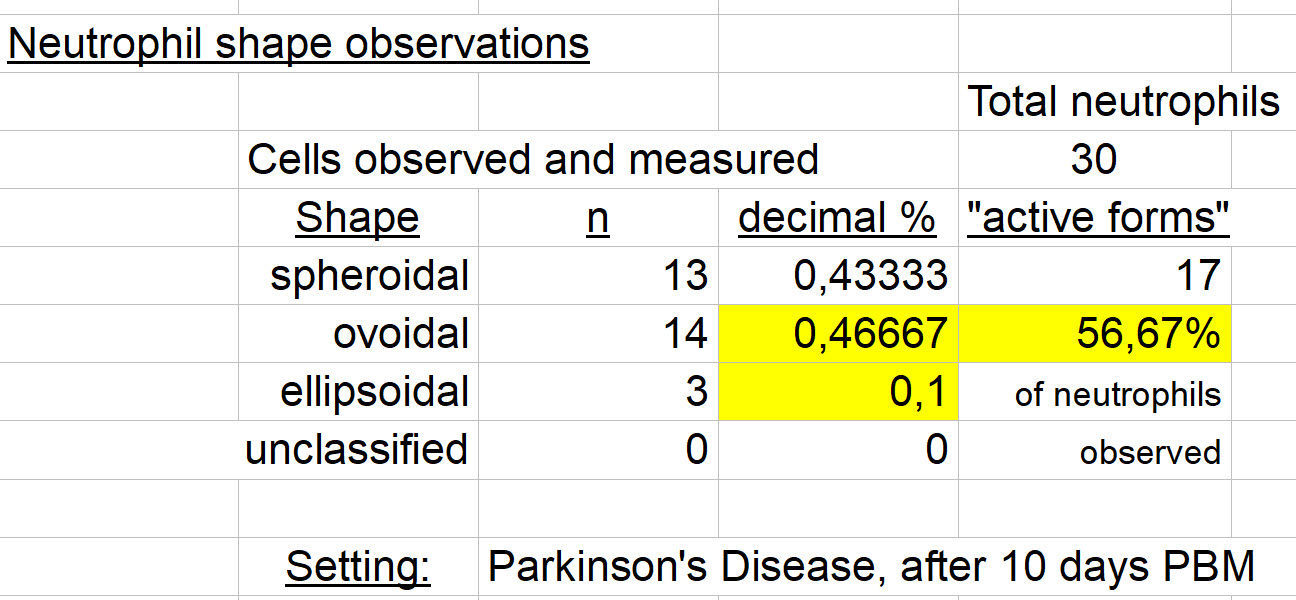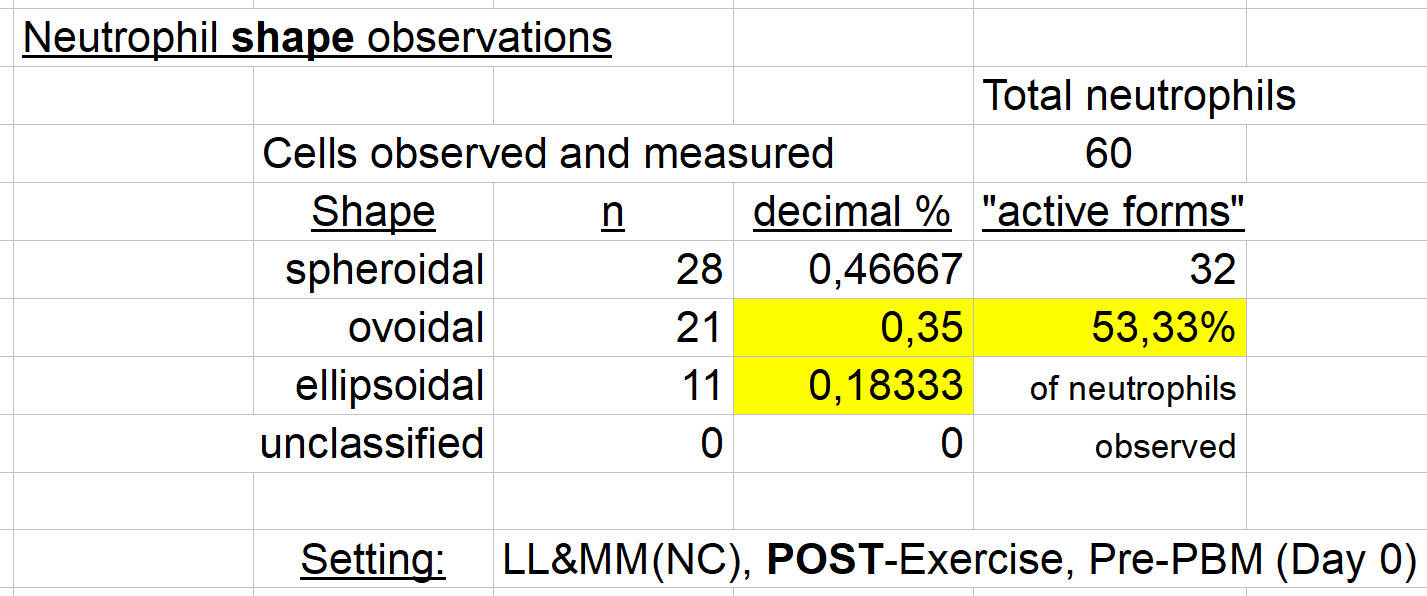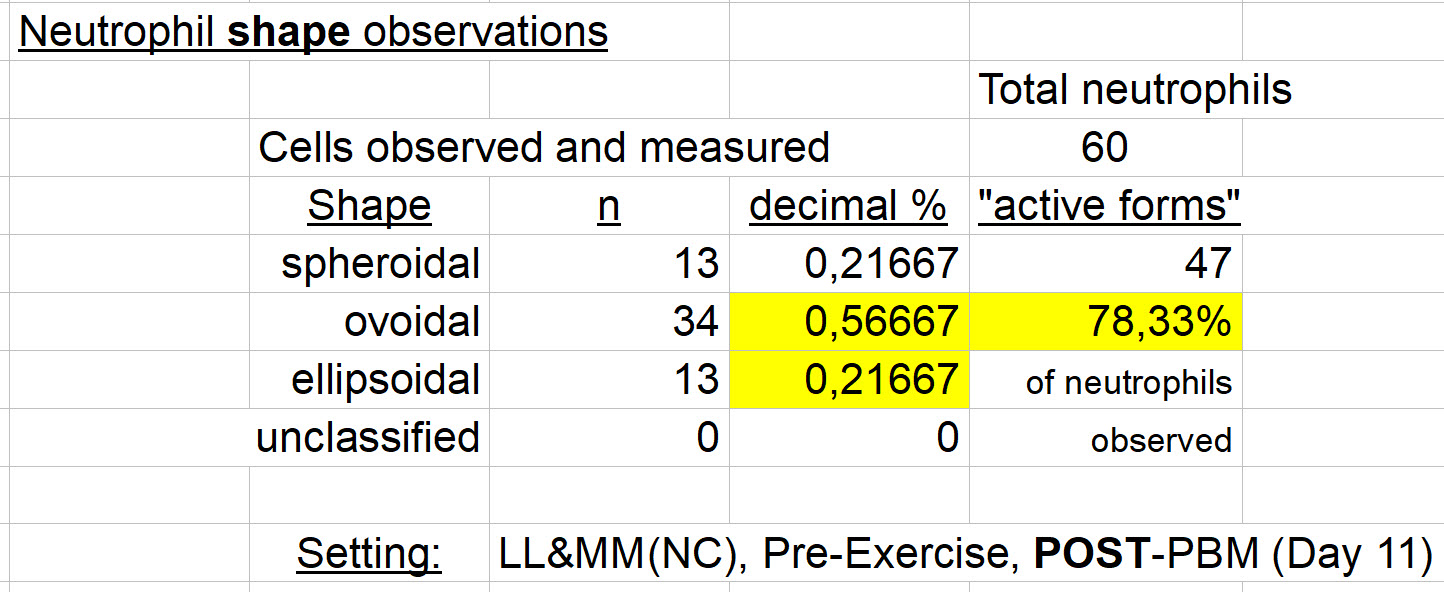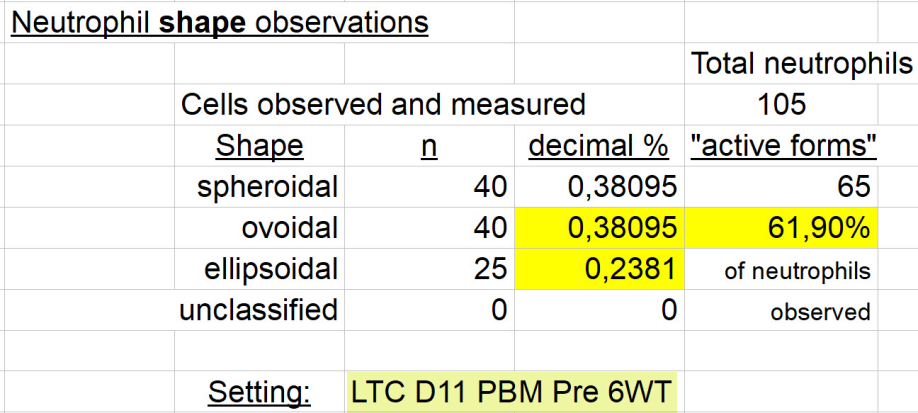Neutrophil Cell Membrane SHAPE Observations
StudyLTCOVID.com
Thanks for visiting!
To translate this page, select your
language from the dropdown menu below:
Before presenting results below, getting a handle on the topic might be helpful.
Results, like in a published journal article, can get pretty dry pretty fast, if not placed in some context. Here is that introductory context. It can be read now or later of course. I put the same link at the bottom of this page.
A list for abbreviations you'll be seeing, is also at the bottom.
A Summary Box is present below. It summarizes all of the separate results sections. If your the kind of person who doesn't like living through the blow-by-blow stepwise process of the Scientific Method, ... you might have a look there right now.
But, no panic as you get into this! Just enjoy the view!
Sneaking up on the Results Observed
... first, some ungrouped observations (like a case presentation, but quicker !), followed by some more controlled comparisons.
---- 1 ----
A 79 year old man decides to get up on a chair outside in a light rain, to change a light bulb over his patio.
He falls.
A neighbor comes to the rescue. He falls too, breaking a few teeth of his dentures.
An ambulance is called and the 79 year old is seen in an ER. His neighbor goes home.
While in the ER, a test is positive for SARS-CoV-2. Nothing is broken. Skipping details of the ER story, he is sent home. (In my car at his wife's request. While at the hospital, I make a peripheral smear slide from his ER blood sample, fix it, stain it and look it over at my place, after getting him safely esconced at his home).
Below, the distribution of his neutrophil cell membrane findings:
I measured and qualified 30 of his neutrophils as to shape, as follows:
Cells that are "ovoidal" and "ellipsoidal" in form, have been highlighted and counted together.
That reflects a belief that they are more active forms of neutrophils, than the "spheroidal" cells. More on that hypothesis, below...
Setting: advanced age, acute mild trauma, an acute COVID-19 infection, (historically his second infection but no tests were done at that time). 90% of his circulating (intravascular) neutrophils are "active" shapes. One might postulate that to respond to an active coronavirus infection (and a little trauma too), one might like to see more "active forms" out in the tissues, leaving fewer to be observed in a sample from the circulation.
Maybe old people just do it that way.
---- 2 ----
The spouse of the above subject; age 77. She has a history of Pakinson's Disease, treated with meds and a surgically implanted brain stem stimulator.
She has elected to try an intervention with light (photobiomodulation, PBM). Here below, results are from a blood sample before starting that intervention (Day 0).
An interesting aside: she and her husband have essentially identical results for the distribution of cell membrane morphologies (shapes). chi-sq. = 0,21818; p = 0,6404, means, no statistical difference.
Supposedly, no acute infection nor minor trauma in her case !
Are the findings related to advanced age? Hard to say. We continue with her results...
Below, results after 10 days of PBM to Head region, 10 minutes/ day.
Are the above results significantly different? : chi-sq. = 10,7555; p = 0,0010
So yes, very different in this single case.
After 10 days of PBM, there is a highly significant difference (reduction) of "active" neutrophil shaped cells in the circulation.
"Why ? We do not know." - quoting my Neuroanatomy Professor, Dr. Johnson in 1972.
Where did they go?
Perhaps out into various tissues of the body to respond to various "calls."
A bit more like "normal controls" as seen below.
Read on.
How about some LTC - related results ?
Okay. (Quick reminder: "LTC" = 'long-term' COVID-19)
Here's an LTC subject before any exercise, and before any PBM (Day 0). The mean neutrophil cell size of 65.282±15.374 sq.microns, is quite abnormally small (nl: 155-160 µm²).
Next: Can one identify any effect of brief exercise (6 min. Walking Test) before PBM (Day 0) ?
(Cell size (area) has now increased to 91.808±18.769 µm², 15 min. after exercise. As noted elsewhere, circulating cell size after brief exercise diminishes in Normal Controls).
Interpretation: No significant difference in Neutrophil SHAPE distributions before and after a 6 minute walking test (6'WT).
(chi-sq. = 0,26666; p = 0,6056), in this LTC subject.
Note also that this is BEFORE any intervention with light.
And after 10 days of PBM to head and back regions in LTC?
(Size (presented elsewhere) has increased to 111.202±19.277 µm². That's close to normal).
chi-sq. = 0,21531; p = 0,6426 So once again, no significant difference in neutrophil shape distribution, pre and post exercise on Day 11 after 10 days of PBM to head and back. Cell size increased significantly as just noted above. Putting that together: larger and more active forms of neutrophils in the vascular space, after an intervention with red and near-infrared light, in LTC.
Do the same neutrophils get out into the tissues more, or less ?
These data don't respond to that question.
Should one be anticipating a change in shape, either due to exercise, or to an intervention with light (PBM) ? What happens to cell membrane shape in Normal Controls ?
Normal Controls (NC) - Before 10 days of PBM and Before exercise (Day 0), compared with
After exercise on the same Day (0):
And now, after 10 days of PBM ...
Here below, Normal Controls, before exercise:
And here below, after exercise:
So are there differences in neutrophil cell membrane shape in normal controls, and if so, what is the impact of brief (6' walking test) exercise ? Are these results additionally modified after an intervention with photobiomodulation (PBM)?
A reminder, "active forms" represent the sum of neutrophils with ovoid and ellipsoid cell membranes. They can be further thought of as transitioning towards an exodus from the capillary (diapedesis) towards a call to action in the surrounding tissues.
Some comparisons, working towards answers to the above questions in these cells from Normal (non-COVID) Controls:
- Brief exercise reduces the number of neutrophils with cell membranes in "active forms." (chi-sq. = 7,17948; p = 0,0074 ), so this is a highly significant result of even brief exercise in "normals." Reported elsewhere, in this phase of the protocol, the size of neutrophils sampled from the circulation was also reduced by brief exercise. "Where did the 'big guys' go?"
- After 10 days of intervention with light, perhaps a difference in the distribution of "active" and "on call" (spheroidal) cell membrane shapes AFTER PBM, in neutrophils (p = 0,1051). While not statistically significant at the usual p<0.05 level, I interpret the values obtained here, as suggesting simply that something is going on. I.e., that there is a mixed effect of exercise and PBM on neutrophil shape in "normals." (Chi-sq. = 2,62653; p = 0,1051 ).
- How about, in Normal Controls, neutrophil shapes associated with brief exercise, before and after PBM ? No significant difference the distribution of "active" and "on call" cell membrane shapes after exercise, done before & after PBM (Chi-sq. = 1,69014; p = 0,1936).
- And in controls, NO EXERCISE, but before and after 10 days of PBM ? No significant difference in "active" and "on call" cell membrane shapes before exercise, before & after 10 d PBM, in neutrophils (Chi-sq. = 0,04778; p = 0,8270). So, in non-COVID normal controls, and avoiding potentially confusing effects of exercise, 10 days of PBM made absolutely no difference in the distribution of observed neutrophil cell membrane shapes, sampled from the circulation by fingerstick. (Just to say the same thing twice, for effect ! No judgements offered about "that's good!" or "that's bad!" It just is).
And when comparing results from those with LTC and these same values from Normal Controls ?
At the risk of sounding a little more scientific, the Null Hypothesis (Ho) states:
1. Pre exercise and pre intervention with light, no difference will be found in the distribution of "active" (Ovoidal and Ellipsoidal) and "on call" (Spheroidal) neutrophil shapes observed in Normal Controls (NC) and those with "long-term" COVID-19 (LTC):
Ho of 'no difference' is accepted. Chi-sq. = 3,20893; p = 0,0732.
But I'll tell you, ... p=0.07 is pretty damn close to being significant at the p<0.05 level, so the result it's trying to tell us something.
The neutrophil size difference looks like this for the same cells observed:
size = a mean area of 88.198±28.758 microns². That has a mean Z-Score of -2.938±2.818. The size for these LTC cells is about 3 standard deviations below the Mean for the Normal Controls. If that means nothing to you: very, very small, suggesting a low cellular energy state. A small cell membrane is easier to maintain than one of normal size, when one is 'running on reserve' as a neutrophil.
Summary: the LTC neutrophils are trending towards more active cell forms, and are definitely smaller neutrophils in the circulation, than those of normal controls.
Ho 2. Post exercise but still pre intervention with light, no difference will be found in the distribution of "active" (Ovoidal and Ellipsoidal) and "on call" (Spheroidal) neutrophil shapes observed in Normal Controls (NC) and those with "long-term" COVID-19 (LTC): 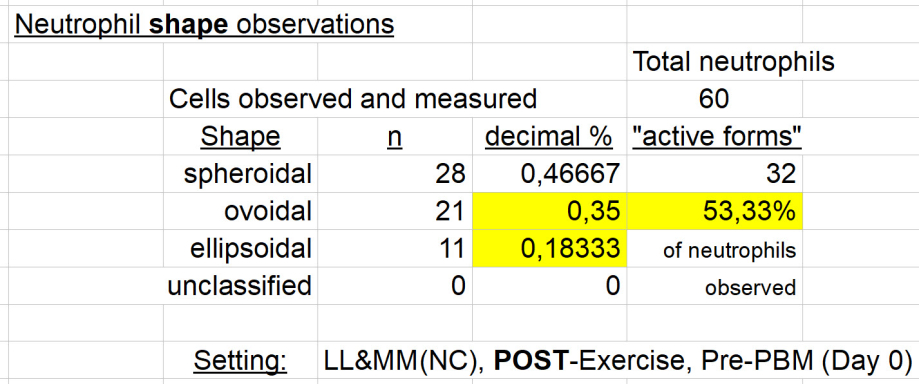
The null hypothesis (Ho) is sustained. No significant difference in the distribution of "active" and "on call" forms of neutrophil cell membranes. (Chi-sq. = 0,08376; p = 0,7723) from LTC subjects, when compared with those from controls.
A reminder: Mean cell size did increase in the LTC subjects (area = 111.395±37.200 µm²) which is still 1.3 standard deviations below normal size, for these 106 neutrophils observed.
Ho 3. Post 10 days PBM and pre exercise, no difference will be found in the distribution of "active" (Ovoidal and Ellipsoidal) and "on call" (Spheroidal) neutrophil shapes observed in Normal Controls (NC) and those with "long-term" COVID-19 (LTC): 
A very significant difference in "active" versus "on call" cell membrane shapes in controls & LTC subjects BEFORE exercise, AFTER 10 d PBM, in neutrophils (Chi-sq. = 4,72639; p = 0,0297). Null Hypothesis of no difference is rejected. A smaller percentage of "active" cell membrane forms in neutrophils from LTC subjects, than in normal controls.
To mention neutrophil size findings, the LTC mean neutrophil area of 133.566±28.883 µm², is essentially normal (Z-Score: 0.3690) after 10 days of PBM.
So, 10 days of PBM in LTC subjects gives results of normalized cell size, and
a circulating neutrophil cell membrane form that shows a difference (fewer active forms) from control values observed. It is conjecture to say that the PBM has "calmed" the level of reactivity of neutrophils in those with LTC, but there. I said it.
Other suggested interpretations are most welcome.
Ho 4. Post 10 days PBM and post exercise, no difference will be found in the distribution of "active" (Ovoidal and Ellipsoidal) and "on call" (Spheroidal) neutrophil shapes observed in Normal Controls (NC), compared with those with "long-term" COVID-19 (LTC):
Controls:
LTC subjects:
Perhaps a difference in "active" and "on call" cell membrane shapes AFTER exercise, AFTER 10 d PBM, in neutrophils (Chi-sq. = 3,20311; p = 0,0735).
One cannot reject the null hypothesis (Ho) of no difference, but again, one might say: "not quite statistically significant." If one develops a little bias, one can push an argument in either direction with such results.
Adding a final word on neutrophil size results here: The result is a Mean area of 152.417±43.844 µm². Well, that value is slightly above normal by Z-Score: 1.551. Call it normal size in neutrophils from LTC subjects, after 10 days of PBM.
Separating out effects of exercise and the intervention with light will require a bit more work to get closer to an understanding.
If one elects to stay quite clean with the statistical results, we have the following situation:
A Summary Table of Results
CONCLUSION
After 10 days of photobiomodulation in subjects with "long-term" COVID-19,
one can no longer find a difference in circulating neutrophil size nor in cell membrane form, when compared with cells from Normal Controls.
I rather like that as a conclusion.
And clearly, the results presented here include implications for further detailed study.
Certainly, this has raised more questions than it has answered.
For example:
- The first result at the top of this page. An elderly man, with an acute COVID-19 illness. Perhaps his second by history. His circulating neutrophils have an abnormal shape distribution, suggesting that they are in a very "active" state. Perhaps, even doing damage within his circulation. Is this finding:
- due to the acute infection ?
- due to his minor trauma (a fall, with nothing broken) hours before ?
- due to his advanced age ?
- his wife has similar findings, and a similar age
- but she has another illness, Parkinson's Disease
- due to something that is also going on in subjects with LTC ?
- they too have neutrophils circulating with a more "active" morphology
- perhaps pertinent, subjects with LTC have many parallels with effects of ageing, and as discussed in the article on this site.
One method for avoiding confusion in results, is to stay quite rigid in limiting subjects and their issues that are going to be studied.
Another method for avoiding confusion in sorting through these types of observations, is to stop making observations.
Surrendering the protocol.
Quitting.
---------
A.
Planning a protocol that investigates the potential effect(s) of an intervention, usually looks like this:
- Clean up the lab
- Find one single question to address
- Do a test, or some tests before, that answer that question
- Do the intervention
- Do the same tests after, as done before
- Make comparisons, validated by appropriate controls and statistical methods
- Explain and distribute what was observed
- So others can consider, compare, repeat, accept, refute, move forwards from there.
B.
Another approach is to simply ask participants if the intervention made them feel better.
That method seems valid for many.
The next participant may be embarking from a starting place that is not too different from the first participant, when this approach is applied.
It may be easier than the protocol method, which somewhere remains comitted to deciphering "the truth" about the question posed:
Identifying the message, without extraneous noise:
Reading the message correctly:
Approaching an understanding of what's next: deciding which port to sail towards.
---------
If one doesn't mind mixing a little "art" in the same cup with one's science, then read on...
---------
Neutrophils behave like tiny hand grenades. Once they get out into the tissues where cells of a tissue have put out a biochemical "call" for assistance, the neutrophil gobbles up the problem, sticks it in a little sac with poison called a vacuole, pulls the pin and explodes the bug or debris inside the sac. Or, it captures it with a NET, (a final parting gesture for the valiant neutrophil !); threrby preparing for its transport and disposal by macrophages or other cells.
But what would happen if, when a neutrophil gets the "call," it can't get out into the tissues, because the capillary wall has problems in those with LTC ?
Or perhaps it's the LTC neutrophil that has a problem with the capillary wall.
They just don't do this, like they loved to do before COVID ...
Then what ?
Well that sounds like a potentially quite farblunget (פארבלאנדזשעט) relationship and situation.
Well, perhaps these increasingly active forms before getting a little PBM, might still just "pull the pin." But wait ! What if they don't do that, out in a tissue with its current problem(s), but instead, in the circulation?
Somehow, a biochemical message to "pull the pin" made its way into the plasma from outside the circulation (called chemoattractants), and attached to one of the receptors on their smallish and energy-poor cell membrane, instantly changing their list of Things To Do. And from their, the usual quick, automatic, explosive response. Not enough energy left to think things over a bit, or waiting for the smoke or turbid plasma to clear: Reacting as usual like the body's Universal Soldier. Boom!
Yikes!
But if their toxic weapons get distributed in the circulation,... in the blood, and then carried around the body, ... perhaps that might cause a few problems.
Perhaps some readers can relate to that farblunget situation.
And for those who don't appreciate the hand grenade image, perhaps you'd prefer a sword.
If so, have a look here: Neutrophil chemoattractant receptors in health and disease: double-edged swords
In the article above, deep and up to date Science is clearly in support of our more imaginative possibilities for what neutrophils are capable of.
And from the above work:
"A chemoattractant gradient determines the direction of neutrophil migration. Activation of chemoattractant receptors induces the upregulation and activation of integrins. Binding of integrins to their ligands enables tight adhesion, eventually leading to trans- or paracellular migration. At the site of infection, neutrophils can phagocytose foreign material, including pathogens, produce reactive oxygen/nitrogen species (ROS/RNS) and release degradative enzymes and microbicidal agents (via degranulation) and neutrophil extracellular traps (NETs)."
Interesting (perhaps for some).
But do integrins have anything to do with SARS-CoV-2 infection and endothelial dysfunction, and as we've been exploring here in our results?
Why, sure they do ...
SARS-CoV-2 Spike triggers barrier dysfunction and vascular leak via integrins and TGF-β signaling
Integrins: Bidirectional, Allosteric Sgnaling Machines
Well, you get the idea.
Could one find a way to just calm these neutrophils down, just a bit ?
"Just a bit" is an important addition. Calm them down too much, and you might be supportive of a pneumonia, or wounds that don't heal.
One example of getting neutrophils to chill out just a bit: colchicine.
---------
"OK. I understand. Who's got the light?"
To other neutrophil articles on this site:
Neutrophil size observations >>>
Morphology in Neutrophils (if not read before) >>>
Neutrophils (several articles to help get over simplistic beliefs) >>>
Can neutrophil-related damage be moderated by other than PBM?
Here's one example that is pertinent:
>>> Lots of info about Colchicine
And another:
>>> Neutrophils and Multiple Sclerosis
List of abbreviations:
NC - Normal Controls
LTC - Long Term COVID
D0 - Day 0 (day of entry into study; before any intervention with light)
D11 - Day 11 (after 10 days of intervention. Usually with light, but in some controls may simply be an interval of time with nothing else.
PBM - photobiomodulation - an intervention with light of wavelength 660 to 670 nm (red), AND 830 to 850 nm (near-infrared) at a desired dose of 40 Joules/ cm².
No PBM - specifically, no light applied for these values obtained (could be applied later for other values presented elsewhere)
Pre 6WT - before a 6 minute walking test. Essentially at rest.
Post 6WT - after a 6 minute walking test. The sample of blood obtained, is as close to immediately after exercise as possible. The two samples (Pre- and Post- are typically 15 minutes apart.
Different Study ID#’s may also appear, and used to identify sample source.
examples: QIc-CM-1979, QI-AJW-1981, QI*OI-MD
They help to group samples logically by individual source identification, different arms of the study, presence of other illnesses, controls, etc.
Spher - spheroidal shape of cell membrane - might be thought of as in a “ready to respond” state, but still rolling around thinking of the last vacation.
Ov & Ellip - ovoid and ellipsoid shape of cell membrane. - might be thought of as “active forms.” They have initiated the response process. I think of them as a hand grenade, with its pin pulled, awaiting being thrown into action. Hopefully in a safe place for the other soldiers on our side.
Funding. No funding or sponsorship was
received for this study or publication of this
article.
That's not exactly right. The author took the hit completely, for all related expenses, and
of which there were quite a few. Money well spent. Some may disagree.



